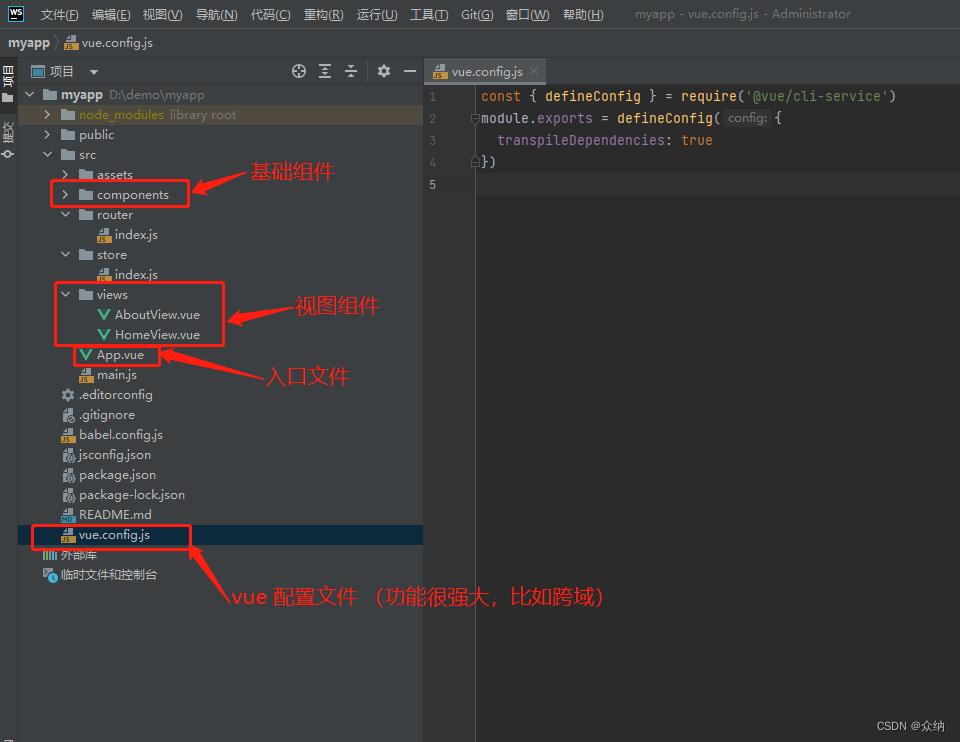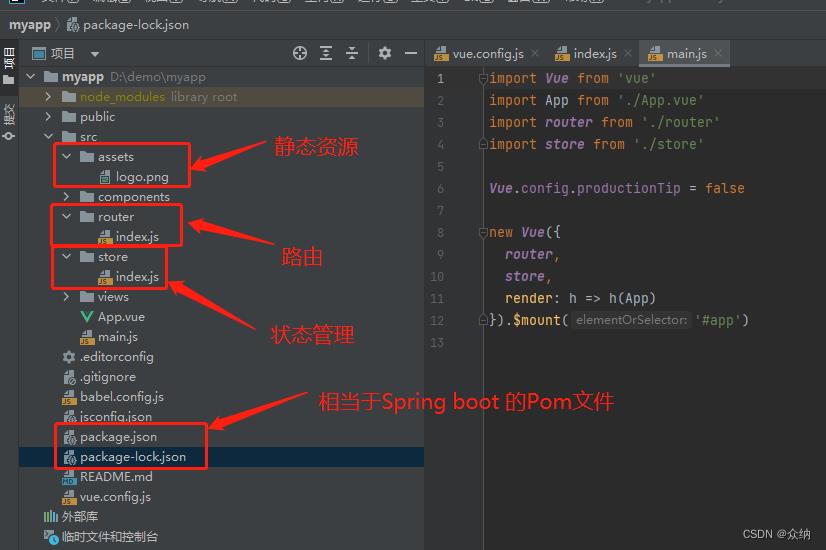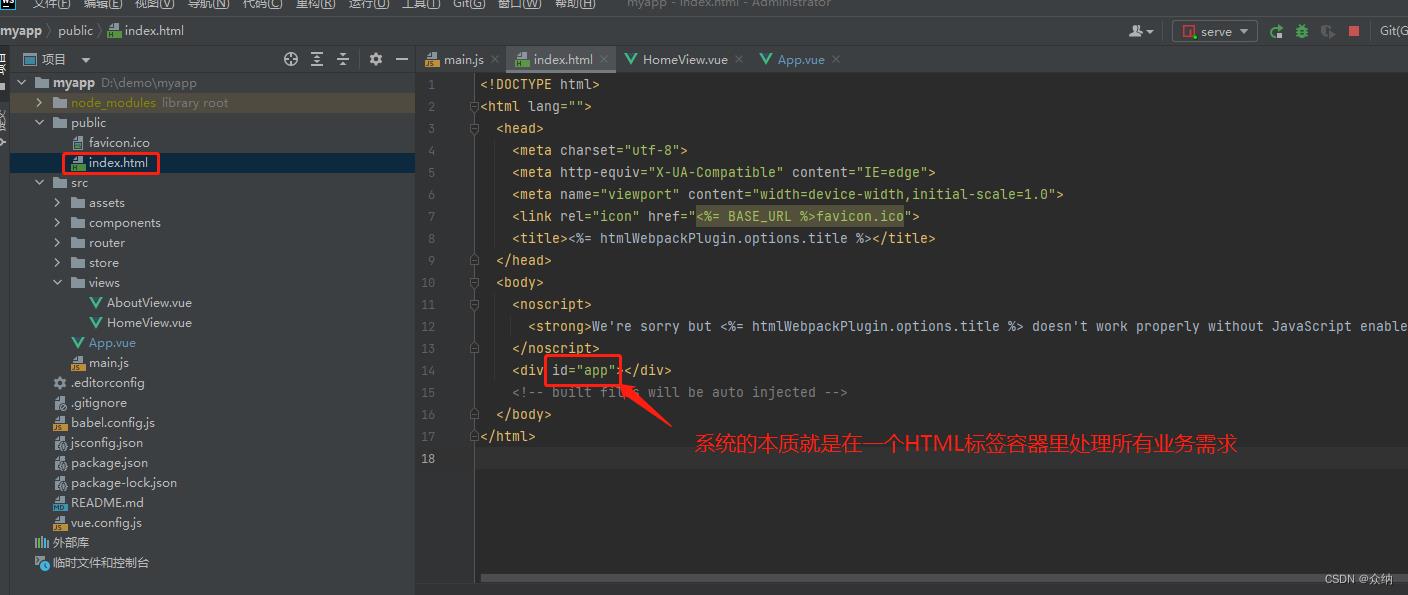我的VUE 学习之路(下)
Posted 众纳
tags:
篇首语:本文由小常识网(cha138.com)小编为大家整理,主要介绍了我的VUE 学习之路(下)相关的知识,希望对你有一定的参考价值。
前言:
在经历过前面在html下的VUE相关基础的洗礼后,我们可以动手去做一些事了,此时发现直接通过直接VUE组件方式与之前在HTML不同,首先要“静一静”,细看之下只是对之前的很多写法做了封装。
本文旨在直接上手Vue项目下做测试而非前面的那种方式。
预期目标:VUE项目开发的基本理解
使用工具:HBuilder
学习前技术储备:VUE 在HTML下的使用
零、准备
注意事项:
创建项目时如果提示:无法加载文件 vue.ps1.......
解决方案:
1.以管理员身份打开windows PowerShell
2.输入:set-ExecutionPolicy RemoteSigned
3.选择y或者a
4.回车 就可以了
一、Vue 项目走步
1.1.项目创建
1.在对应的目录上支行CMD或终端
2.输入 vue create XXX [xxx 是项目名称]
3.选择配置(如下图)通常情况下需要手动配置

4.手动配置 选项说明
4.1Babel (默认选中)(选中)
4.2 TypeScript --TS库
4.3 Progressive Web App...
4.4 Router --路由组件(建议选中)
4.5 Vuex --状态组件(建议选中)
4.6 CSS Pre-processors --样式管理(建议选中)
4.7 Linter / Formatter(默认选中)(个人不推荐 稍有错误就会提示错误,影响开发速度)
4.8 Unit Testing --测试
4.9 E2E Testing --测试
5.创建就慢慢等
6.创建后可以使用WebStrom 、VScode 、Hbuilder以项目的打开(导入)就可以了
1.2.项目结构


1.3.项目文件

系统处理顺序个人理解是:public/index.html -> main.js->App.vue(如果不对请留言指正)
1.4.项目示例
HomeView.vue 文件调用模组Demo.vue
<template>
<div class="home">
<img alt="Vue logo" src="../assets/logo.png">
<!-- <HelloWorld msg="Welcome to Your Vue.js App"/>-->
<demo></demo>
</div>
</template>
<script>
// @ is an alias to /src
// import HelloWorld from '@/components/HelloWorld.vue'
import Demo from '@/components/Demo'
export default
name: 'HomeView',
components:
// HelloWorld,
Demo
</script><template>
<div>
msg
<input type="text" ref="mytest">
<button @click="test()">测试</button>
<ul>
<li v-for="data in inputData" :key="data">data</li>
</ul>
</div>
</template>
<script>
// 接口
export default
// eslint-disable-next-line vue/multi-word-component-names
name: 'Demo',
// 数据层
data ()
return
msg: '这是一个Demo',
inputData: []
,
// 事件
methods:
test ()
// eslint-disable-next-line no-sequences,no-unused-expressions
console.log(this.$refs.mytest.value),
this.inputData.push(this.$refs.mytest.value)
</script>
二、反向代理概念
它存在的意义在于解决跨域问题,主要是通过修改vue.config.js 处理。
(ps:修改后要重新启动一下才生效)
const defineConfig = require('@vue/cli-service')
// 示例解决 http://t.163.move/getMove/getById?10
module.exports = defineConfig(
transpileDependencies: true,
devServer:
proxy:
'/getMove': // API标识
target: 'http://t.163.move', // 代理标识
// wss: true,
changeOrigin: true
)
// 调用 axios.get("/getMove/getById?10").then(res=>res.data)
三、路由
路由顾名思意就是负责转发或跳转的,与我们生活中的路由器的工作方式相同;在下载的文件中包含了一个示例(router\\index.js),所有接受路由的地方需要用<router-view></router-view>容器接收。
一级路由
其实VUE在创建时就给示出一个一级路由实例;
App.vue
<template>
<div id="app">
<nav>
<router-link to="/">Home</router-link> |
<router-link to="/about">About</router-link> |
</nav>
<router-view/>
</div>
</template>
<style lang="scss">
#app
font-family: Avenir, Helvetica, Arial, sans-serif;
-webkit-font-smoothing: antialiased;
-moz-osx-font-smoothing: grayscale;
text-align: center;
color: #2c3e50;
nav
padding: 30px;
a
font-weight: bold;
color: #2c3e50;
&.router-link-exact-active
color: #42b983;
</style>
router\\index.js
import Vue from 'vue'
import VueRouter from 'vue-router'
import HomeView from '../views/HomeView.vue'
Vue.use(VueRouter)
const routes = [
path: '/',//访问路径
name: 'home',//命名
component: HomeView //外部注册 这里直接使用
,
path: '/about',
name: 'about',
component: () => import(/* webpackChunkName: "about" */ '../views/AboutView.vue')//内部引用
]
const router = new VueRouter(
mode: 'history',//路由模式 展示方式
base: process.env.BASE_URL,
routes
)
export default router
多级路由
作用:用于访问子路径 通常使用在二级目录配置
Demo.vue 模拟父(注意定义对应接收标签)
<template>
<div>
这是一个Demo 为的是展示二级(多级)路由
<!-- 设置好容器-->
<router-view></router-view>
</div>
</template>
定义两个子组件 A.vue 与B.vue
<template>
<div> A </div>
</template><template>
<div>B</div>
</template>
配置路由新增
path: '/demo',
name: 'demo',
component: Demo,
children:[
path:'a',
name:'a',
component:A
,
path:'b',
name:'b',
component:B
]
动态路由
用途:主要用于路径是变化,但格式固定,通常使用在列表中的详情页
ProductDetail.vue 模拟产品详情
<template>
<div>
这是一个组件
<div> id</div>
</div>
</template>
<script>
export default
data()
return
id:""
,
mounted()
this.id=this.$route.params.id
</script>AboutView.vue 模拟数据(产品)列表页,用于发出明细请求
<template>
<div class="about">
<h1>This is an about page</h1>
<ul>
<li v-for="data in list" :key="data.id" @click="theProduct(data.id)">
data
</li>
</ul>
</div>
</template>
<script>
export default
data()
return
list:[id:1,code:"aa",id:2,code:"bb",id:3,code:"cc"]
,
methods:
theProduct(id)
this.$router.push(`/detail/$id`)//指向router这个目录下的配置实现跳转 动态路由方式1
//this.$router.push(name:"detail",params:id:id)//动态路由方式2 通过命名路由方式跳转
</script>
路由配置
import Vue from 'vue'
import VueRouter from 'vue-router'
import HomeView from '../views/HomeView.vue'
import ProductDetail from '../components/ProductDetail'
Vue.use(VueRouter)
const routes = [
path: '/',//访问路径
name: 'home',//命名
component: HomeView //外部注册 这里直接使用
,
path: '/about',
name: 'about',
component: () => import(/* webpackChunkName: "about" */ '../views/AboutView.vue')//内部引用
,
path:'/detail/:id',
name:'detail',
component: ProductDetail
]
const router = new VueRouter(
mode: 'history',//路由模式 展示方式
base: process.env.BASE_URL,
routes
)
export default router
路由拦截
作用:路由前的校验,一般用于登陆等
如下代码在路由js中添加进去代表当不是demo路径的访问就放行
//路由拦截配置
router.beforeEach((to,from,next) =>
if (to.name !=='demo')
next()
)路由定向
作用:当访问未在路由内部配置的路径时要自动指向指定的路径
如下配置当访问 .../demo/c的时候自动转向.../demo这个路径上
path: '/demo',
name: 'demo',
component: Demo,
children:[
path:'a',
name:'a',
component:A
,
path:'b',
name:'b',
component:B
,
//重定向
path: '*',
redirect:'/demo'
]
全部示例代码
components\\productDetail.vue
<template>
<div>
这是一个组件
<div> id</div>
</div>
</template>
<script>
export default
data()
return
id:""
,
mounted()
this.id=this.$route.params.id
</script>
router\\index.js
import Vue from 'vue'
import VueRouter from 'vue-router'
import HomeView from '../views/HomeView.vue'
import ProductDetail from '../components/ProductDetail'
import Demo from '../views/Demo'
import A from '../views/Demo/A'
import B from '../views/Demo/B'
Vue.use(VueRouter)
const routes = [
path: '/',//访问路径
name: 'home',//命名
component: HomeView //外部注册 这里直接使用
,
path: '/about',
name: 'about',
component: () => import(/* webpackChunkName: "about" */ '../views/AboutView.vue')//内部引用
,
path:'/detail/:id',
name:'detail',
component: ProductDetail
,
path: '/demo',
name: 'demo',
component: Demo,
children:[
path:'a',
name:'a',
component:A
,
path:'b',
name:'b',
component:B
,
//重定向
path: '*',
redirect:'/demo'
]
,
//重定向:在顶级目录中不存在的数据自动指向首页
path: '*',
redirect:'/'
]
const router = new VueRouter(
mode: 'history',//路由模式 展示方式
base: process.env.BASE_URL,
routes
)
//路由拦截配置
// router.beforeEach((to,from,next) =>
// if (to.name !=='demo')
// next()
//
// )
export default router
views\\AboutView.vue
<template>
<div class="about">
<h1>This is an about page</h1>
<ul>
<li v-for="data in list" :key="data.id" @click="theProduct(data.id)">
data
</li>
</ul>
</div>
</template>
<script>
export default
data()
return
list:[id:1,code:"aa",id:2,code:"bb",id:3,code:"cc"]
,
methods:
theProduct(id)
this.$router.push(`/detail/$id`)//指向router这个目录下的配置实现跳转 动态路由方式1
//this.$router.push(name:"detail",params:id:id)//动态路由方式2 通过命名路由方式跳转
</script>
views\\Demo.vue
<template>
<div>
这是一个Demo 为的是展示二级(多级)路由
<!-- 设置好容器-->
<router-view></router-view>
</div>
</template>
views\\Demo\\A.vue
<template>
<div> A </div>
</template>
views\\Demo\\B.vue
<template>
<div>B</div>
</template>
App.vue
<template>
<div id="app">
<nav>
<router-link to="/">Home</router-link> |
<router-link to="/about">About</router-link> |
<router-link to="/detail">detail</router-link>
</nav>
<router-view/>
</div>
</template>
<style lang="scss">
#app
font-family: Avenir, Helvetica, Arial, sans-serif;
-webkit-font-smoothing: antialiased;
-moz-osx-font-smoothing: grayscale;
text-align: center;
color: #2c3e50;
nav
padding: 30px;
a
font-weight: bold;
color: #2c3e50;
&.router-link-exact-active
color: #42b983;
</style>
四、Vuex
vuex 是Vue家族中的状态管理工具。PC端常用于权限管理,移动端则多数用于懒加载。其配置文件前文已介绍就是store目录下的index.js文件。请大家看我针对这个文件的注释
import Vue from 'vue'//引用vue
import Vuex from 'vuex'//引用状态管理
import axios from 'axios'
Vue.use(Vuex) //加载
//导出
export default new Vuex.Store(
state:
//---------------作用:共享数据 第三个加载
productList:[]
,
getters:
//---------------作用:数据二次加工方法
getProductListTop3(state)
return state.productList.filter((item,index)=>index<4)
,
mutations:
//---------------作用:配置系统常量比如登陆的账户信息、权限信息等 第二个加载
setProductList(state,data)
state.productList=data
,
actions:
//---------------作用:异步加载 条件执行,常用于懒加载 第一个加载
getProductList(store)
axios(
url:"http://127.0.0.1:2022/company-work-time/findByCompanyId?companyId=74"
).then(res=>
//state.productList=res.data;
store.commit("setProductList",res.data.data)
console.log(res.data.data)
)
,
modules:
//---------------状态树,暂时用不到,一般较大项目使用,相当于声明一个子对象一样包含state\\getters...
)1.先加载actions,它主要用于做数据请求。
2.请求过来的数据通过mutations的方法把数据存入state中的变量中去。
3.如果前端需要二次处理,则把方法写在getters中去。
示例
App.vue
<template>
<div id="app">
<nav>
<router-link to="/">Home</router-link> |
<router-link to="/about">About</router-link> |
<router-link to="/storeDemo">storeDemo</router-link>
</nav>
<router-view/>
</div>
</template>
<style lang="scss">
#app
font-family: Avenir, Helvetica, Arial, sans-serif;
-webkit-font-smoothing: antialiased;
-moz-osx-font-smoothing: grayscale;
text-align: center;
color: #2c3e50;
nav
padding: 30px;
a
font-weight: bold;
color: #2c3e50;
&.router-link-exact-active
color: #42b983;
</style>StoreDemo.vue
<template>
<div>
<h3>演示状态管理</h3>
<h5>1:懒加载</h5>
<ul>
<li v-for="data in $store.state.productList" :key="data.id">
data
</li>
</ul>
</div>
</template>
<script>
export default
data()
return
pList:[]
,
mounted()
if (this.$store.state.productList.length===0)
this.$store.dispatch("getProductList")
else
console.log("启用缓存数据")
this.pList=this.$store.state.productList
</script>
五、elementUI 、MintUI
其实这方面的教程非常多,而且官方相当详尽,在这里只是给大家提醒有这么一个东西,首先它是界面优化的(可以理解为基于VUE的皮肤),Element 是针对PC端的,Mint是针对移动端的。以下是官方连接方便大家查用
总结
个人觉得VUE最大的亮点:
1.组件化开发【像是乐高积木,越细分越灵活】
2.数据双向绑定
结论:
作为一名开发人员不应该抱着固有的思想看问题,一项技术出来并且有生命力指定有它的先进性,我们要主动拥抱它!我遇到很多技术人员总在讲:“XXXX已经足够用了”、“用XXX也能实现这个需求(除了麻烦点)”,更有过者讲:“XXX不好用(其实用都没有用过就发表看法)”............遇到这些人我们尽量远离切不可与之争论,因为这些负能量会影响到你!
文未提醒大家这是我学习近两周后的一些个人心得与技术总结,难免有一些差错,届时希望大家批评指正,同时原创不易,欢迎收藏转发。
vue学习之路 - 4.基本操作(下)
vue学习之路 - 4.基本操作(下)
简述:本章节主要介绍 vue 的一些其他常用指令。
Vue 指令
这里将 vue 的指令分为系统内部指令(vue 自带指令)和用户自定义指令两种。
系统内部指令
v-if
v-else
v-else-if
v-for
v-on
v-bind
v-model
以上指令前面都已说明其作用,并且使用过,这里将不再赘述。
下面我们看看 vue 的一些其他常用指令的用法:
在学习 v-text 和 v-cloak 之前我们先看看{{ }}的使用所存在的问题。
{{ }}存在的问题:页面初始化时,可能会出现闪烁问题。当数据量越大的时候,这个问题就更加明显。
如下面这段代码:

<!DOCTYPE html> <html lang="en"> <head> <meta charset="UTF-8"> <title>vue- {{ }} 的闪烁问题</title> </head> <body> <!----------{{ }} 存在的闪烁问题------------------------------> <!-- 为什么{{ }}会在页面加载时出现闪烁? 答:浏览器自上而下一次对页面代码进行解析,当解析到<h1>{{ foo }}</h1>的时候,浏览器会直接把{{ foo }} 当做h1标签的内容直接渲染出来。 然后解析到了Vue之后,Vue就要从入口管理模板,解析{{ foo }}变成了foo的值:hello 中间这个阶段就会一闪而过。 --> <div id="app"> <h1>{{ foo }}</h1> <h1>{{ foo }}</h1> <h1>{{ foo }}</h1> <h1>{{ foo }}</h1> <h1>{{ foo }}</h1> </div> <script src="node_modules/vue/dist/vue.js"></script> <script> // 得到 Vue 实例 const app = new Vue({ el: ‘#app‘, data: { foo : ‘hello‘ } }) </script> </body> </html>
运行效果:初次加载或者重新加载界面,都有可能会在界面闪一下显示出{{ }}的符号。
解决{{ }}闪烁问题的方案有两种:
① 使用v-text指令,替换{{ }}
② 使用v-cloak指令,作用与整个被vue 管理的 div 块。
详情请看下面 v-text 和 v-cloak 指令介绍。
v-text
v-text 的使用效果和{{ }}的作用差不多,但是 v-text 不存在闪烁问题。
v-text使用Demo:
- 和{{ }}一样的,唯一的区别就是,{{ }}会造成闪烁问题,v-text不会造成闪烁问题
- 如果还想用{{ }}又不想有闪烁问题,则用v-cloak指令来处理。(详情看v-cloak指令)

<!DOCTYPE html> <html lang="en"> <head> <meta charset="UTF-8"> <title>vue-指令 v-text</title> </head> <body> <!-- 用v-text解决闪烁问题 --> <div id="app"> <h1 v-text="foo"></h1> <h1 v-text="foo"></h1> <h1 v-text="foo"></h1> <h1 v-text="foo"></h1> <h1 v-text="foo"></h1> </div> <script src="node_modules/vue/dist/vue.js"></script> <script> // 得到 Vue 实例 const app = new Vue({ el: ‘#app‘, data: { foo : ‘hello‘ } }) </script> </body> </html>
v-cloak
- 如果想用{{ }}进行数据显示,又不想有闪烁问题,则使用v-cloak来处理
■ 先在在样式表添加一个特殊样式[v-cloak] { display: none }
■ 然后在被vue管理的模板入口节点上作用v-cloak指令。
- 原理:加上这个display:none的属性后,默认一开始被vue管理的模板时隐藏的,当vue解析处理完DOM模板后,会自动把这个样式去除,然后显示出来
Demo:

<!DOCTYPE html> <html lang="en"> <head> <meta charset="UTF-8"> <title>vue-指令 v-cloak</title> </head> <body> <!-- 如果你还是想要使用{{ }}进行数据显示的话,可以使用v-cloak解决闪缩问题 --> <!-- 用v-cloak解决闪烁问题 --> <!-- 原理:默认给div内容是display: none的样式, 但是当vue加载完成后,会自动将v-cloak去除。 --> <style type="text/css"> [v-cloak] { display: none; } </style> <div id="app" v-cloak> <h1>{{ foo }}</h1> <h1>{{ foo }}</h1> <h1>{{ foo }}</h1> <h1>{{ foo }}</h1> <h1>{{ foo }}</h1> </div> <script src="node_modules/vue/dist/vue.js"></script> <script> // 得到 Vue 实例 const app = new Vue({ el: ‘#app‘, data: { foo : ‘hello‘ } }) </script> </body> </html>
v-html
把要显示的字符串当做 html 代码来进行渲染。
Demo:

<!DOCTYPE html> <html lang="en"> <head> <meta charset="UTF-8"> <title>vue-指令 v-text</title> </head> <body> <div id="app" v-cloak> <!-- 普通的文本绑定渲染:结果会当做字符串直接渲染 --> <div>{{ htmlStr }}</div> <!-- 使用v-html指令的文本渲染,会将这段文本当做HTML代码进行渲染 --> <div v-html="htmlStr"></div> </div> <script src="node_modules/vue/dist/vue.js"></script> <script> // 得到 Vue 实例 const app = new Vue({ el: ‘#app‘, data: { htmlStr : ‘<div>我是一段HTML文本</div>‘ } }) </script> </body> </html>
运行效果:

注意:v-html 的文本渲染会对里面的脚本进行过滤,遇到脚本会忽略过去,不执行。
- Vue在这里做了安全处理,如果发现有script标签,则不渲染
- 原因:防止XSS攻击。
XSS攻击:XSS攻击就是利用往网页注入js脚本,读取cookie,发送到黑客服务器中或者直接在你访问的这个网站,当你结算账单的时候,跳转到钓鱼网站
v-show
根据表达式之真假值,切换元素的 display css 属性。
作用:条件控制元素的显示或隐藏
- 无论真假,都会渲染在DOM结构中
■ 条件为真,则让display显示
■ 条件为假,则让display不显示
建议:如果需要频繁的显示或隐藏切换,则使用v-show
v-if 和 v-show的区别:
v-if:
- 真正的条件渲染,不满足渲染条件都不会渲染在DOM结构中
- 条件为真,则渲染这个DOM
- 条件为假,则移除或不渲染这个DOM
- 建议:如果只是一次显示和隐藏的控制,则建议使用v-if
v-pre
跳过这个元素和它的子元素的编译过程。可以用来显示原始 Mustache 标签。跳过大量没有指令的节点会加快编译。

<!DOCTYPE html> <html lang="en"> <head> <meta charset="UTF-8"> <title>vue-指令 v-pre</title> </head> <body> <!-- v-pre --> <div id="app" v-cloak> <!-- Vue 不处理带有 v-pre 指令的DOM元素 例如:一个网页的一篇文章,文章内容就不需要被Vue管理渲染。 所以我们就可以在文章内容节点上加v-pre来忽略这个DOM处理 用以提高性能 --> <!-- 正常的块内容, vue 都会对其编译解析 --> <h1>{{ foo }}</h1> <!-- v-pre 内为原生的 html 编译 --> <div v-pre> <h1>{{ foo }}</h1> </div> </div> <script src="node_modules/vue/dist/vue.js"></script> <script> // 得到 Vue 实例 const app = new Vue({ el: ‘#app‘, data: { foo : ‘hello‘ } }); </script> </body> </html>
使用效果:

v-once
只渲染元素和组件一次。随后的重新渲染,元素/组件及其所有的子节点将被视为静态内容并跳过。这可以用于优化更新性能。
Demo:

<!DOCTYPE html> <html lang="en"> <head> <meta charset="UTF-8"> <title>vue-指令 v-pre</title> </head> <body> <div id="app"> <!-- v-once内的DOM元素只渲染一次,后面就算数据更新了 v-once内的DOM元素都不会再更新渲染。 --> <div v-once> <h1>{{ foo }}</h1> <h1>{{ foo }}</h1> <h1>{{ foo }}</h1> </div> </div> <script src="node_modules/vue/dist/vue.js"></script> <script> // 得到 Vue 实例 const app = new Vue({ el: ‘#app‘, data: { foo : ‘hello‘ } }) </script> </body> </html>
运行效果:

自定义指令
除了核心功能默认内置的指令 (v-model 和 v-show),Vue 也允许注册自定义指令。注意,在 Vue2.0 中,代码复用和抽象的主要形式是组件。然而,有的情况下,你仍然需要对普通 DOM 元素进行底层操作,这时候就会用到自定义指令。
注册绑定方式:
- 关于指令的名字
■ 名字中不要加v-前缀(只有使用的时候才加)
■ 如果有多个单词,则建议使用驼峰命名法
■ 在使用的时候,首先加v-前缀,然后对于驼峰命名法的指令要转换为小写,用-拼接起来。
全局注册
■ Vue.directive(‘指令名称’, { 配置参数 } );
■ 如果是全局指令,则一定要在实例化Vue之前注册
■ 全局注册在所有组件(实例)中都可以使用
■ 建议:如果需要在任何组件中可能使用的指令把其注册成全局指令
全局注册Demo:
// 注册一个全局自定义指令 `v-focus` Vue.directive(‘focus‘, { // 当被绑定的元素插入到 DOM 中时…… inserted: function (el) { // 聚焦元素 el.focus() } })
局部注册
■ 通过组件中的选项directives来注册(组件内容在下一章节将介绍)
■ 指令的名字作为directives对象的成员
■ 局部自定义指令只能在这个组件(实例)中使用
■ 建议:如果只是在某个组件中使用(其他组件不可能用到),这个时候注册为组件局部指令
directives: { focus: { // 指令的定义 inserted: function (el) { el.focus() } } }
自定义指令的使用:
像系统指令一样的使用方式操作即可使用。
<input v-focus>
指令的生命钩子函数:
- bind
■ 只调用一次,指令第一次绑定到元素时调用。在这里可以进行一次性的初始化设置。而且在这个阶段拿不到父元素。
- inserted
■ 被绑定元素插入父节点时调用 (仅保证父节点存在,但不一定已被插入文档中)。
■ 如果你需要操作作用指令的父元素,则最起码写到这个 inserted 中
- update
■ 指令的绑定的值发生更新的时候才会触发调用,获取的是更新的之前的指令所在的 DOM 内容
- componentUpdated
■ 指令的绑定的值发生更新的时候才会触发调用,获取的是更新之后的最新 DOM 内容
- unbind
■ 只调用一次,指令与元素解绑时调用。
// bind 和 inserted 的相同之处是一上来都执行一次,以后再也不会执行
// 异同之处在于,bind 拿不到父元素,inserted 可以拿到父元素
钩子函数参数
el:指令所绑定的元素,可以用来直接操作 DOM 。binding:一个对象,包含以下属性:name:指令名,不包括v-前缀。value:指令的绑定值,例如:v-my-directive="1 + 1"中,绑定值为2。oldValue:指令绑定的前一个值,仅在update和componentUpdated钩子中可用。无论值是否改变都可用。expression:字符串形式的指令表达式。例如v-my-directive="1 + 1"中,表达式为"1 + 1"。arg:传给指令的参数,可选。例如v-my-directive:foo中,参数为"foo"。modifiers:一个包含修饰符的对象。例如:v-my-directive.foo.bar中,修饰符对象为{ foo: true, bar: true }。
vnode:Vue 编译生成的虚拟节点。具体可以参考 VNode API 解更多详情。oldVnode:上一个虚拟节点,仅在update和componentUpdated钩子中可用。
注意:除了 el 之外,其它参数都应该是只读的,切勿进行修改。如果需要在钩子之间共享数据,建议通过元素的 dataset 来进行。
基本操作:

<script type="text/javascript"> Vue.directive(‘focus‘, { // 只调用一次,指令第一次绑定到元素时调用。在这里可以进行一次性的初始化设置。 bind (el) { console.log(‘bind 第一次绑定元素‘) }, // 只调用一次,被绑定元素插入父节点时调用 (仅保证父节点存在,但不一定已被插入文档中)。 // 如果需要对父节点进行操作,则代码写在此处 inserted (el) { console.log(‘inserted‘, el.parentNode) }, // update 拿到的是数据改变视图之前的视图内容,可以通过比较更新前后的值来忽略不必要的模板更新。 update () { console.log(‘update‘) }, // componentUpdated 拿到的是数据改变视图之后的视图内容 componentUpdated () { console.log(‘componentUpdated‘) }, // 只调用一次,指令与元素解绑时调用。 unbind () { console.log(‘unbind‘) } }) </script>
函数简写:
在很多时候,你可能想在 bind 和 update 时触发相同行为,而不关心其它的钩子。
比如这样写:
- 模拟v-show
<script type="text/javascript"> // 很多时候,我们都会在 bind 和 update 中执行相同的代码 // 所以我们可以使用简写方式,直接给一个函数,该函数会作为 bind 和 update 的时候执行的函数 Vue.directive(‘my-show‘, function (el, binding) { if (binding.value) { el.style.display = ‘block‘ } else { el.style.display = ‘none‘ } }) </script>
- 模拟v-bind
<script type="text/javascript"> Vue.directive(‘my-bind‘, function (el, binding) { el.setAttribute(binding.arg, binding.value); }) </script>
以上是关于我的VUE 学习之路(下)的主要内容,如果未能解决你的问题,请参考以下文章
